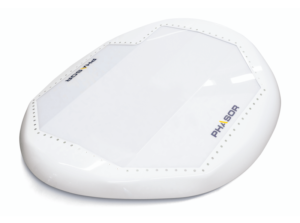Phasor, Inc., the leading developer of enterprise-grade phased array antenna systems, announced today, June 08 2017, that together with DSM, they are developing a unique protective cover (radome) made with Dyneema® for phased array, electronically steerable antennas (ESAs).
These radomes with Dyneema® feature exceptional properties designed to achieve optimal performance across all satellite mobility use-cases.
 Randomes
Randomes
Radomes are essential to shield satellite communications antennas from adverse weather and harsh conditions but are often bulky, heavy, difficult to manage, and can reduce an antenna’s efficiency. The companies are working together under a long-term agreement to leverage Phasor’s unique knowledge in the field of ESAs, and DSM’s extensive experience with advanced Ultra High Molecular Weight PolyEthylene (UHMWPE materials) for use in radio frequency (RF) applications.
Dave Helfgott, CEO, Phasor, Inc, said:
“With near-zero signal loss, Dyneema® Crystal technology helps Phasor optimize it’s powerful new ESA for aeronautical, maritime and land-mobile applications”
“In addition to the material’s electromagnetic transparency, Phasor chose Dyneema® for its superior protection of sensitive equipment in harsh outdoor environments and its extreme light weight which is critical for commercial mobility applications.”
Koen Janssen, Vice President Innovation, DSM Dyneema, added:
“Phasor’s state-of-the-art Electronically Steered Antenna systems are another excellent example of how Dyneema® Crystal Technology is helping customers create radically new solutions and underscores DSM’s commitment to supporting our customers with the most advanced materials on the market today”
Phasor’s Electronically Steerable Antennas
Phasor’s very low profile, electronically steerable antennas (ESA’s) provide high-bandwidth service in a more reliable, robust and failure-tolerant way. The antenna is solid-state, with no moving parts, so satellite signals are tracked electronically. The ESA can be flat or conformal in design and can be fitted more seamlessly to moving vehicles, including an aircraft fuselage, a cruise-ship or a high-speed train. The same technology is very well suited to support traditional fixed satellite networks (FSS), High Throughput Satellites (HTS), and Non-Geosynchronous (NGSO) satellite networks. Moreover, the antenna’s modular architecture allows the system to be scaled to any use-case requirement, fixed or mobile.
For further information, and to view Phasor’s informational videos, please click here.



















